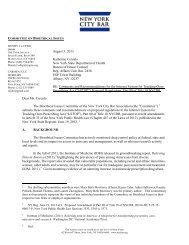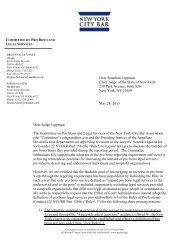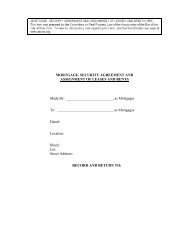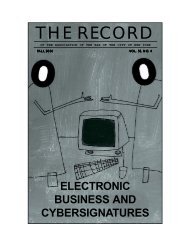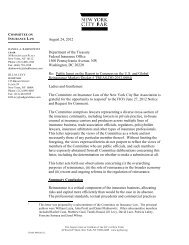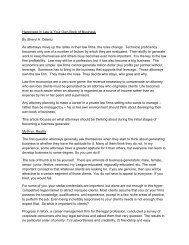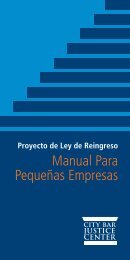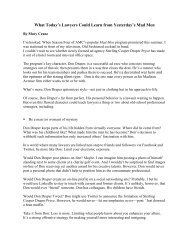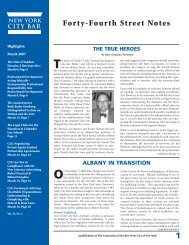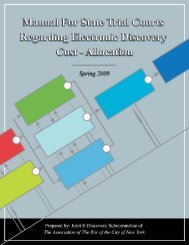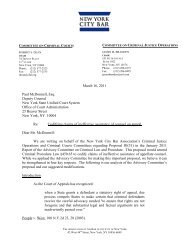2007 Issue 1 - New York City Bar Association
2007 Issue 1 - New York City Bar Association
2007 Issue 1 - New York City Bar Association
You also want an ePaper? Increase the reach of your titles
YUMPU automatically turns print PDFs into web optimized ePapers that Google loves.
P R O F E S S I O N A L A N D J U D I C I A L E T H I C S<br />
The reasons why a lawyer may seek to bypass outside counsel and<br />
communicate directly with in-house counsel are many and varied; some<br />
may be salutary or at least innocuous (e.g., to break an impasse in negotiations<br />
with outside counsel; to make a time-sensitive communication<br />
when outside counsel is incommunicado; to take advantage of a particularly<br />
good working relationship with in-house counsel from prior matters),<br />
while others may be less so (e.g., to seek to marginalize outside counsel<br />
in order to diminish his or her effectiveness). It is possible that, in some<br />
cases, a lawyer in a matter may be attempting to drive a wedge between<br />
in-house and outside counsel by contacting in-house counsel directly. Yet,<br />
such a communication would not exploit the imbalance of power inherent<br />
in lawyer-layperson contact that is the concern of DR 7-104(A)(1). For<br />
example, when a party retains two or more outside counsel, it is permissible<br />
for a lawyer for another party in the matter to contact any of them<br />
without the others’ permission. Even though this could indirectly undermine<br />
the attorney-client relationship as between the adverse party and<br />
the lawyers excluded from the communication, DR 7-104(A)(1) has no<br />
bearing on the issue.<br />
As a general proposition, the applicability of the Rule should not<br />
turn on the subjective motivations of the communicating lawyer because<br />
of the difficulty in assessing actual motivations after the fact and the<br />
possibility of mixed or unprovable motives. Nor should the permissibility<br />
of contact depend on data likely to be unknowable to the attorney seeking<br />
to make the contact. Cf. Simon, supra note 3. Such a fact-specific,<br />
subjective test would reduce the predictive value of the Rules and chill the<br />
prudent practitioner from making even those contacts with in-house counsel<br />
that are not prohibited by the Rules—effectively turning DR 7-104(A)(1)<br />
into a blanket “no-contact” rule for any reasonably cautious lawyer who<br />
wishes to communicate with in-house counsel.<br />
A number of authorities have recognized that in-house counsel often<br />
play multiple roles in an organization, including purely business roles.<br />
See, e.g., U.S. Postal Serv. v. Phelps Dodge Ref. Corp., 852 F. Supp. 156, 160<br />
(E.D.N.Y. 1994) (“[I]n house counsel . . . frequently have multi-faceted<br />
duties that go beyond traditional tasks performed by lawyers. House counsel<br />
have increased participation in the day-to-day operations of large corporations.”)<br />
4 For that reason, it would be inappropriate to conclusively pre-<br />
4. Many of those authorities arise in the context of a challenge to the privileged status of a<br />
communication between an in-house counsel and another employee of the organization on<br />
the ground that the in-house counsel was communicating in a business, not a legal, capacity.<br />
Because the application of the attorney-client privilege turns on considerations significantly<br />
T H E R E C O R D<br />
152



